When gardens produce abundance, they create habitat for other living things. Plants, animals, insects and fungi interact with each other to create ecosystems.
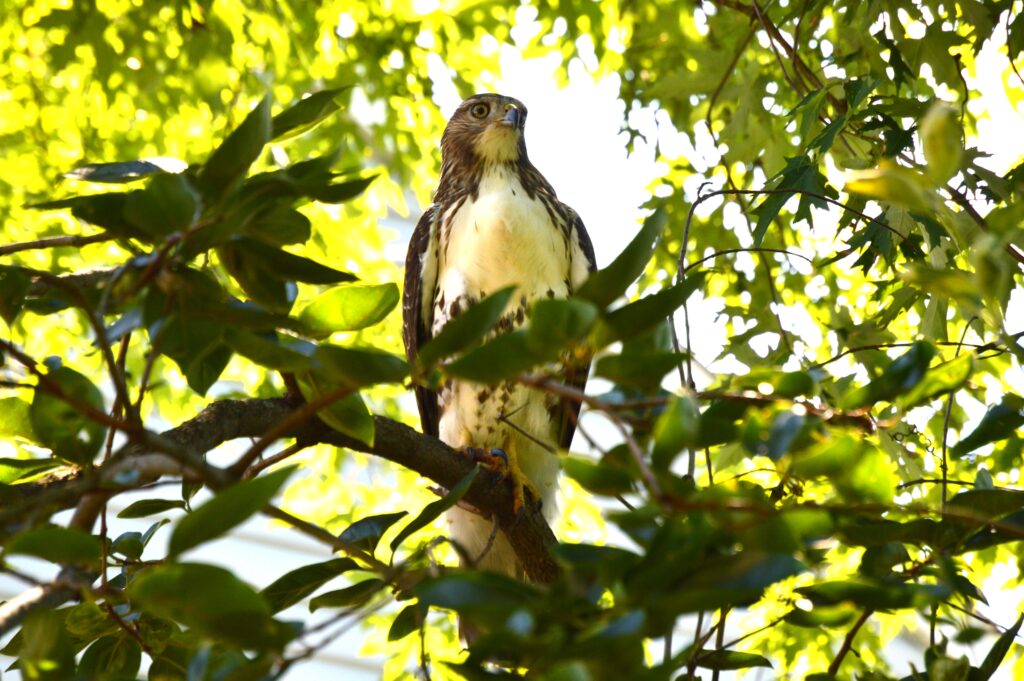
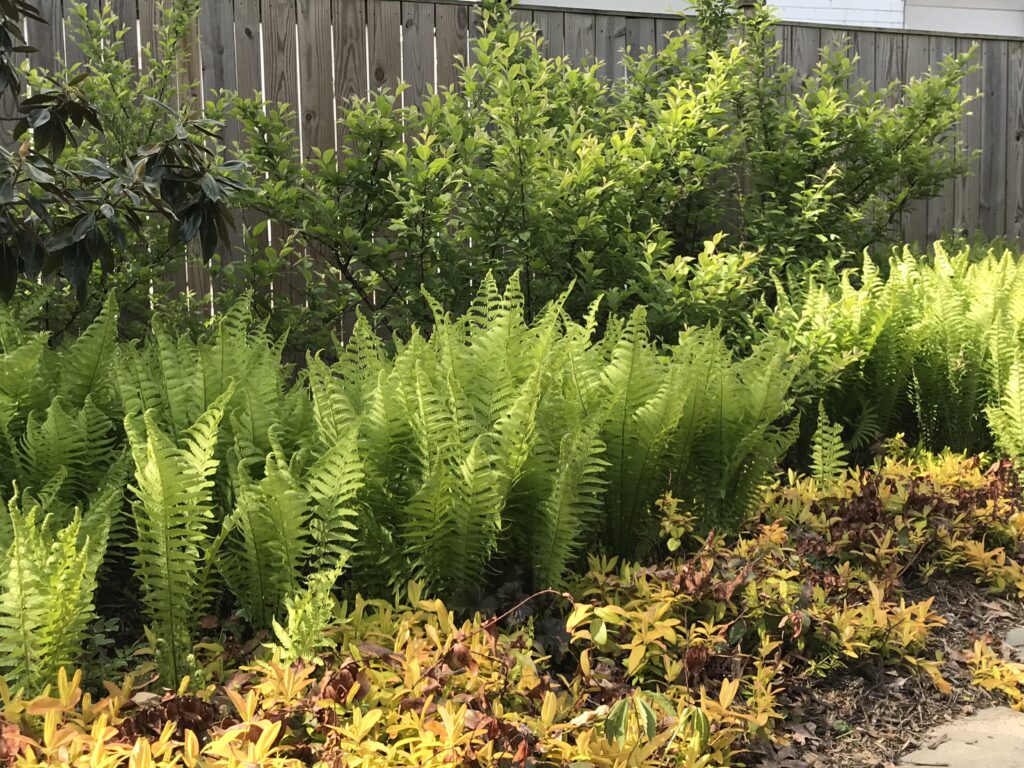
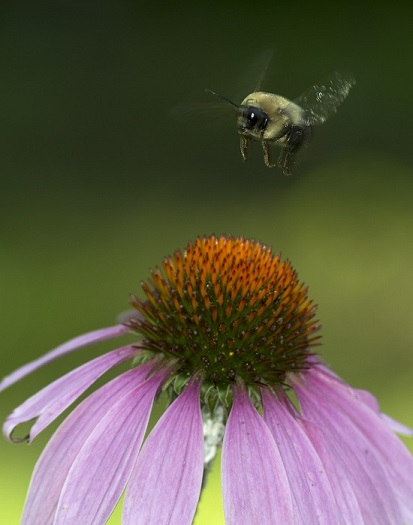
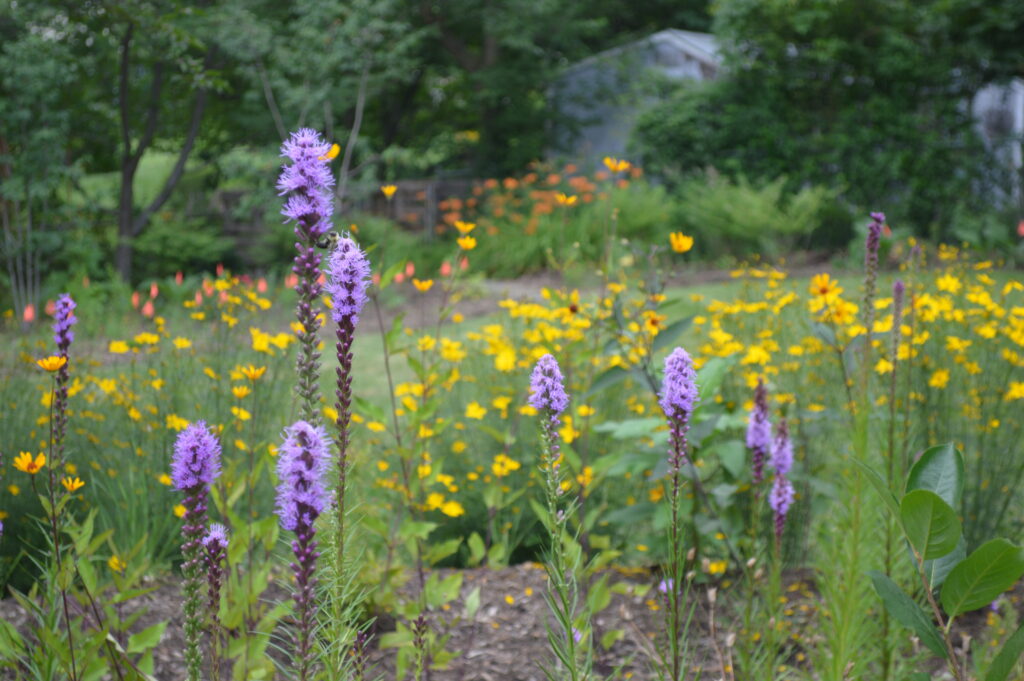
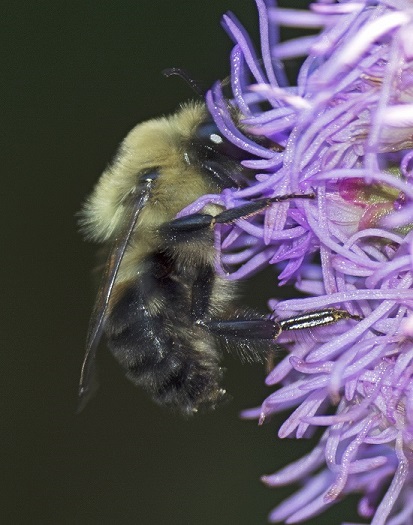
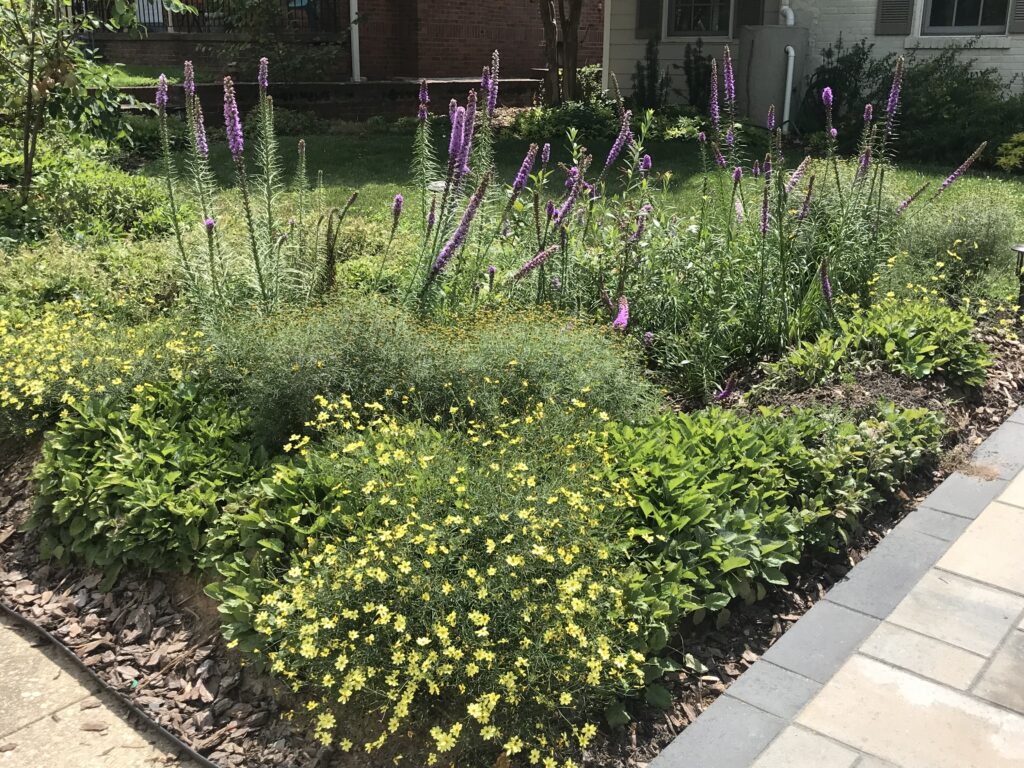
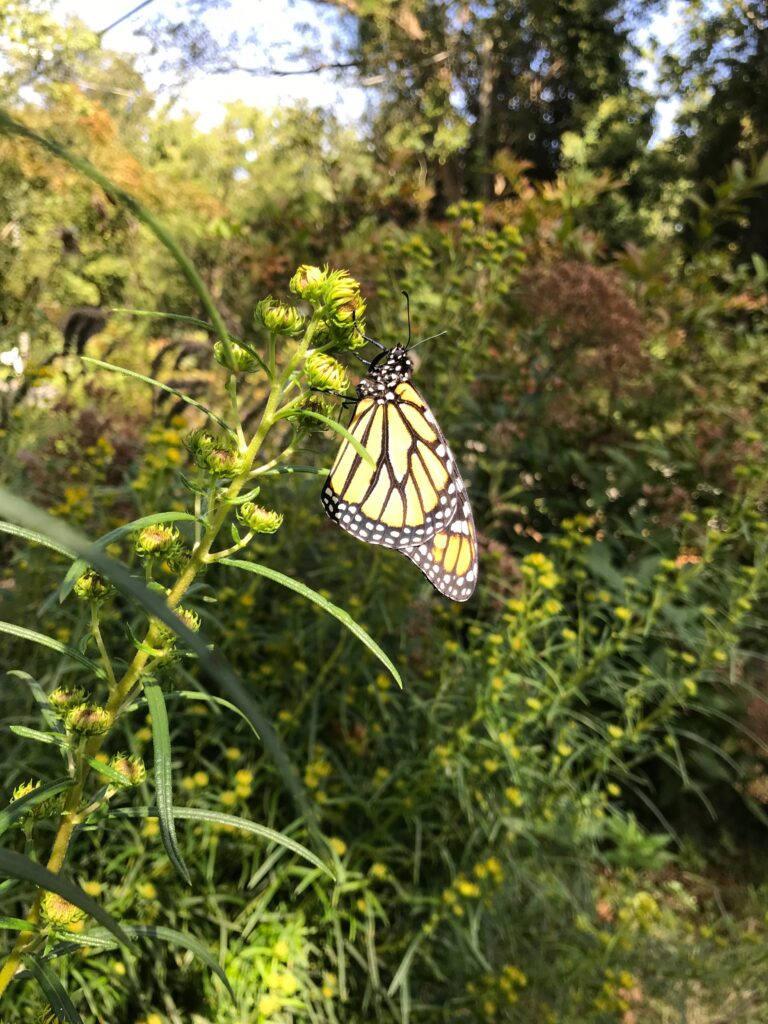
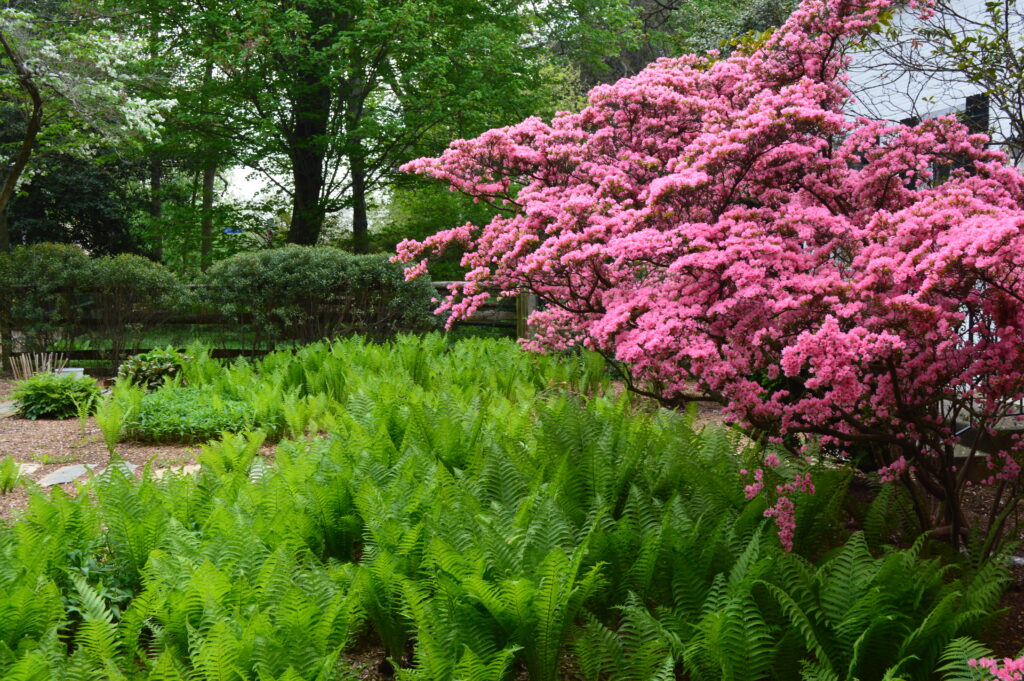
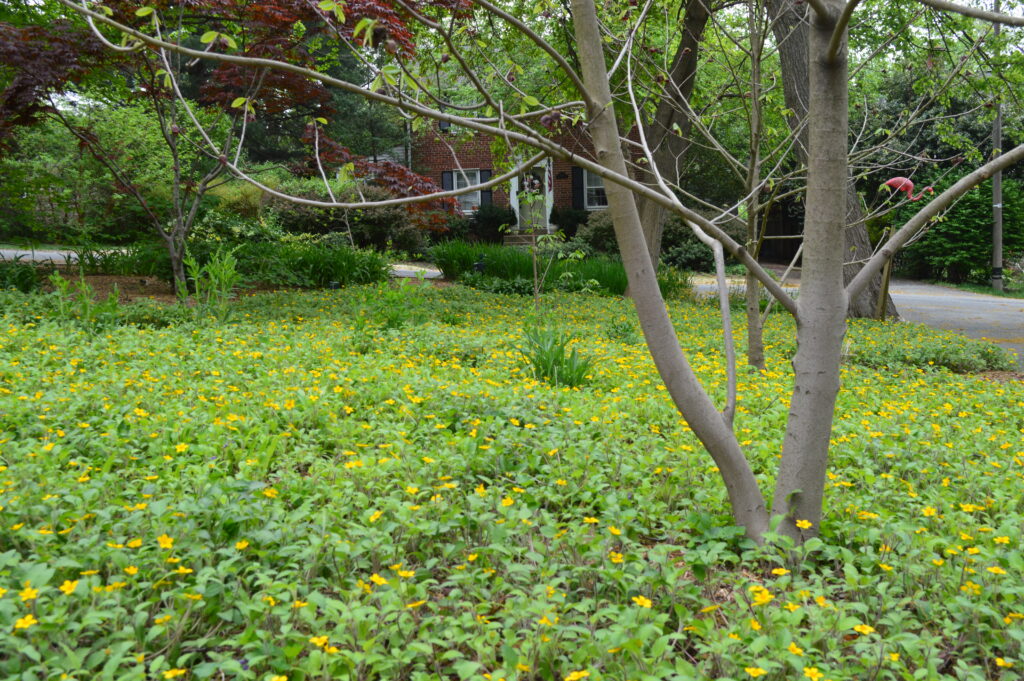
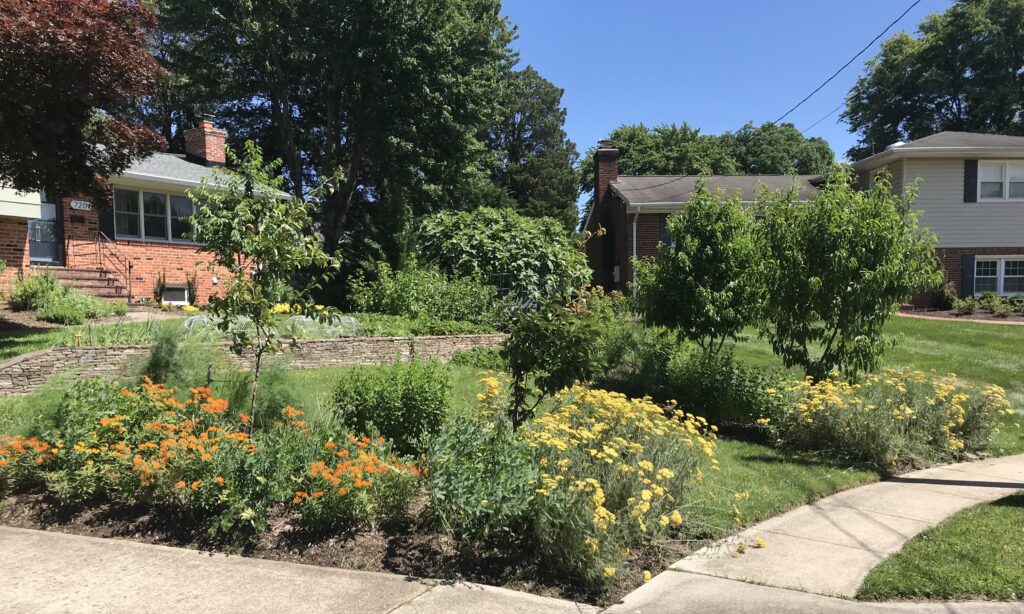
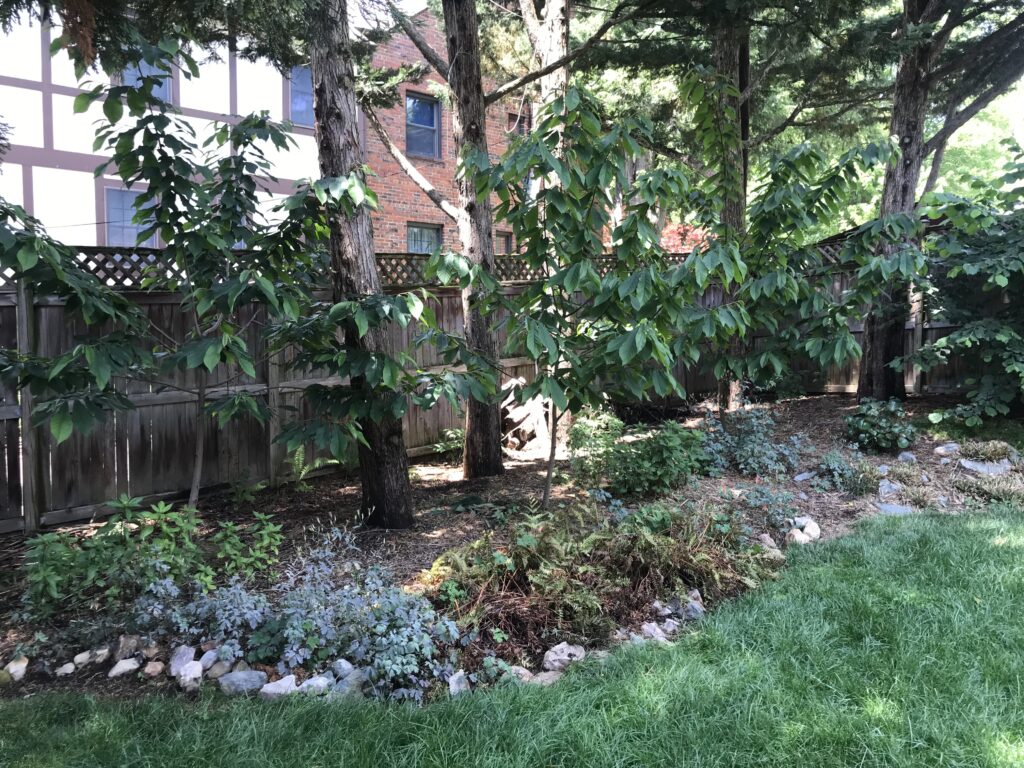
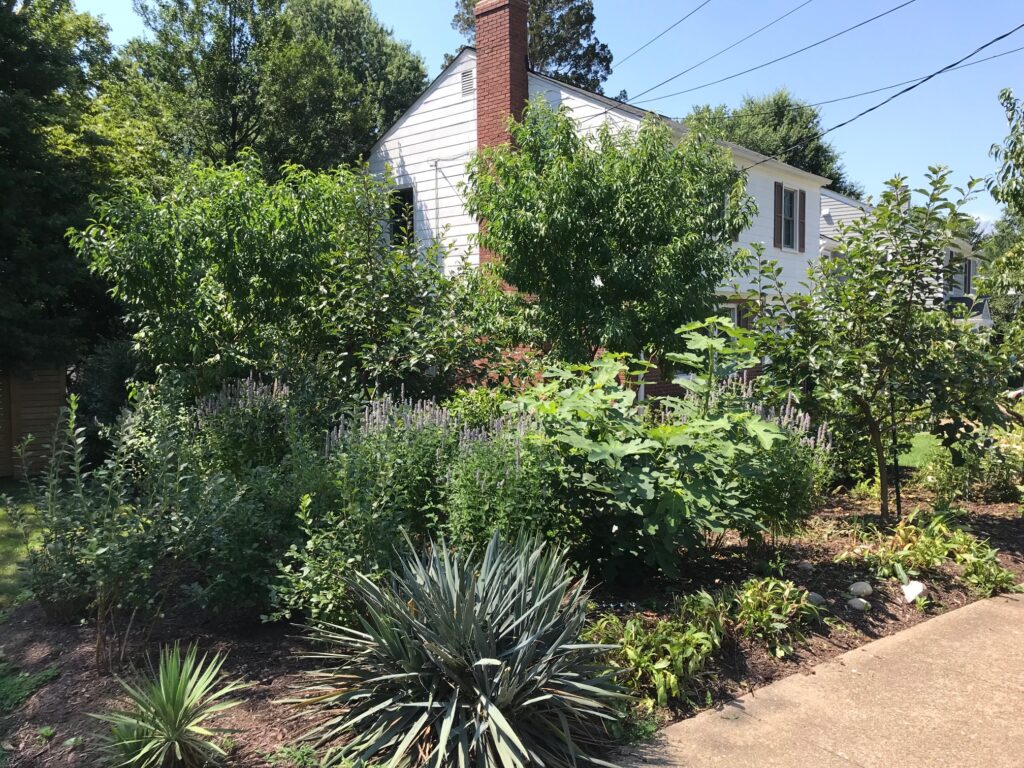
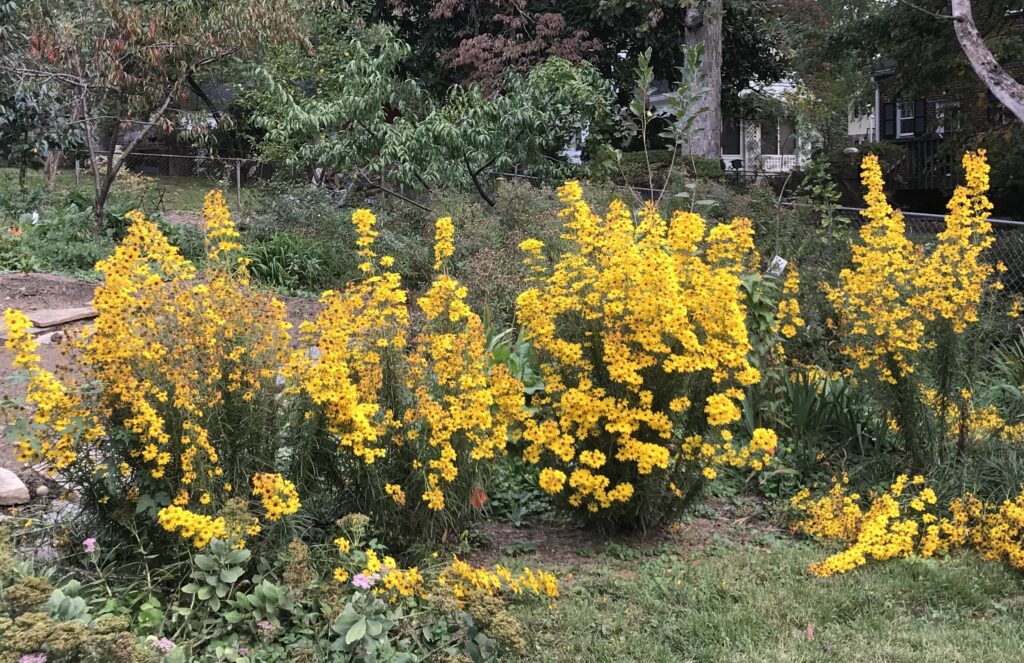

When gardens produce abundance, they create habitat for other living things. Plants, animals, insects and fungi interact with each other to create ecosystems.













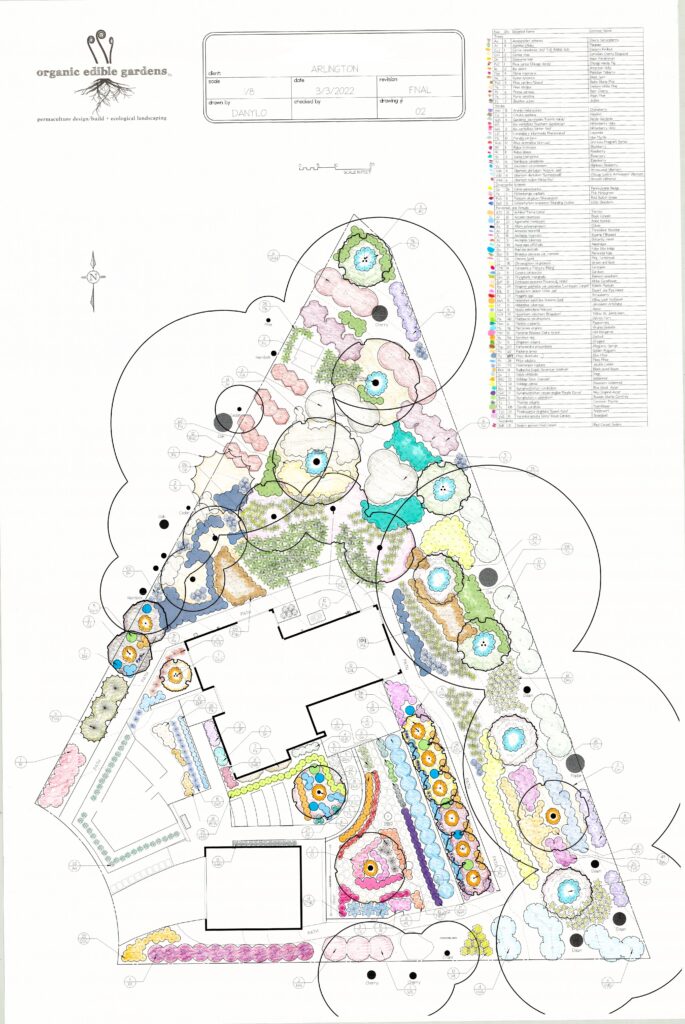
What no lawn? Yes! This landscape design for a client in Arlington is full of native and edible plants instead of a lawn!
The front contains a large vegetable garden surrounded by two layers of 4′ deer fencing with asparagus in between and native meadow plants as a backdrop.
Flagstone steps take you to a terraced plateau filled with Asian pears, blueberries, persimmons, sour cherries, cornelian dogwoods, a fig and a plethora of native flowers that attract beneficial insects.
The shady back slope is held together by serviceberries, paw paws, hazelnuts, elderberries, fragrant sumac and various native ground covers and spreading perennials.
Viburnums, wax myrtles, and a few hollies surround the property to provide privacy and bird habitat.
A couple of black gum trees (Nyssa sylvatica) provide shade for an open forest floor of edible ostrich fern and other woodland natives.
Ornamental, Edible and Native Landscape
A plethora of plants both front and back are traversed by curved pathways and stone walls. The cut flagstone front walk leads you through a mix of classical ornamentals like boxwood, peonies, tulips, and crape myrtles with unusual ornamental edible plants like black lace elderberry, rugosa roses, aronia berry, lavender and some native ornamentals like pink turtlehead, rhododendron and virginia sweetspire.
The two mulch paths in the back carry one through a canopy of twisted and muscular American Hornbeams on one side and a tasty grove of currants and elderberries on the other both leading to a gazebo surrounded by pawpaws, and mature hardwoods.
The back contours are accented by curved retaining walls that ameliorate an eroding slope and terrace the ground for Asian Persimmons and Sweet Cherries. Sedges, edible ferns and day lilies make up a flat woodland clearing that serves as a play area for the kids.
The rear of the property is a daunting invasive Ailanthus grove on a steep slope. After removing the invasive species, the space gives way to a sunny slope appropriate for a food forest. It is comprised of Paw paw, Asian persimmon, Cherry and Peach. Companion plants include Indigobush, False Blue Indigo, Pink Turtlehead, Butterfly Milkweed and Anise Hyssop.
The front yard is full of edible natives like American Hazelnut, Blueberry, Elderberry and Currant paired with ornamental natives like Dogwood, Redbud, Bayberry, Echinacea, Asters and Virginia Bluebells.
We designed this food forest utilizing the sun exposure in a woodland clearing. In order to stabilize the slope we recommended terracing the slope with logs from the property. The terracing will slow down water flow and prevent erosion while the newly installed plants are getting established.
In order to maximize sun exposure, the larger trees were placed to the north and or downhill of the smaller plants. The woody plant pallet is comprised of low maintenance food bearing trees and shrubs like pawpaw, persimmon, Chinese chestnut, elderberry and blueberry. The herbaceous plants are comprised of soil building plants like comfrey and false blue indigo, insect attracting plants like echinacea and yarrow, woodland medicinals like goldenseal and american gingseng and some edible ferns.
We designed zones 1 and 2 of a 13 acre permaculture homestead in Purcellville, Virginia. Zones 1 and 2 refer to the most visited and maintained areas on a property. They are also the areas closest to the house.
In the immediate areas surrounding the house we included a chicken coup with surrounding paddocks. Each paddock contains plants that are harvested at similar times of year. For example, one fenced in area contains summer ripening fruits, while another contains fruits that are ripe in the spring or fall. This way the chickens can be kept out of the gardens when the fruit is ripe, but can roam freely through the gardens at other times.
In the front of the house is an extensive annual vegetable garden laid out on contour with keyhole herb beds and keyhole perennial vegetable beds.
All of the water draining off of the back of the roof fills a pond designed for edible aquatic plants and native fish. The pond captures valuable fresh water and turns it into a beautiful and productive body of water.
Extending out further from Zone 1 we designed 2 large forest gardens containing nearly every fruit and nut that can be grown in this area. Accompanying the food producing trees and shrubs are nitrogen fixing, dynamic accumulating, beneficial insect attracting and pest confusing herbaceous perennial plants. The fruits and nuts include Peach, Apple, Cherry, Almond, Filbert, Pawpaw, Persimmon and various berries.
Lining the driveway are 12 English Walnut trees and 24 Mulberry trees, creating a shaded enclosed entrance to the property. The Mulberry trees act as a buffer to the plant growth inhibiting compound emitted by walnut trees called Juglone.
Extending further out from the driveway are two single row grape trellises accompanied by Rugosa Roses and Lavender. The roses and lavender not only add beauty to the front of the property but also aid in pest and disease prevention for the grapes.
For this design, the client was ready to part with their lawn. In place of it we designed a garden with lots of flowers and food. They have a south facing front yard which is an ideal location for food producing perennial plants and a vegetable garden. The north facing back yard with mature tree canopy is the ideal location for a patio, fire pit, hammock and shade loving plants. The woody plantings are laid out on contour with infiltration swales to catch rain water. The tree species include Asian Persimmon, Sour Cherry, Asian Pear and Pawpaw. The property has a total of 18 Blueberry plants as well as Currants, Elderberry and Aronia. Herbaceous plants include Strawberry, Asparagus, Culinary herbs, dynamic accumulators, nitrogen fixers and numerous beneficial insect attracting plants.
By Danylo Kosovych and Organic Edible Gardens LLC
When it comes to rainwater collection the first thing people think about are rain barrels but you don’t need a barrel to collect rain water. Rain barrels are useful if you want to store water and use it for irrigation but for storm water management they are dwarfed by amount of rainfall that falls in the average storm. Once inch of rain falling over a 1000 square foot roof produces 600 gallons of water. A 50 gallon rain barrel only catches 1/12 of the water. A 600 gallon water tank is not only large and obtrusive but also expensive.
Not to worry, rainwater collection can be achieved in multiple ways without using a container at all. Below are examples of multiple ways we have collected rainwater using the earth as the container.
You can catch rain water in a swale:
A swale is a depression in the earth, dug on contour and linear in shape, therefore adept at catching runoff. This client had runoff problems from their neighbor. We created a swale along the property line to catch and infiltrate the runoff before it entered their property. The Elderberries and Aronia benefit from the additional water.
You can catch rain water in a rain garden:
A rain garden is a bowl shaped depression that works well to catch stormwater from a downspout. We later planted this one with Aronia, Low- Bush Blueberries and native perennial flowers. The soil in the center is deeply tilled and the water infiltrates rapidly, while the plants benefit from the additional water.
Or you can use perforated pipe to leach rain water into the soil:
This is a vegetable garden which we created on contour and directed the roof runoff into a perforated pipe and buried the pipe in gravel. All of the water from the roof infiltrates into the soil and waters the vegetable beds.
Here we used the same principal with the infiltration pipe but planted columnar apple trees on top of the pipe. Now the water from the roof irrigates the apple trees.
©2013 Jonathan Storvick and Organic Edible Gardens LLC
“Swales” and other rainwater-harvesting earthworks are an integral part of the sustainable landscape. Harvesting rainwater is by no means a new concept – humans have been capturing and storing rainwater for at least 6000 years, probably longer. From the cisterns of ancient Rome to today’s ubiquitous 55-gallon rain barrels, people have utilized the free and precious resource of rainwater for every water need from irrigation to bathing and drinking. Yet the use of tanks, cisterns and barrels can only be a small part of any sustainable water strategy.
This is because catchment itself is only part of the need. First, there is the simple matter of quantity – more water falls from the sky than we can possibly capture and use for our needs. For example, a 1-inch rainstorm falling on a 1000 square-foot roof generates more than 600 gallons of water – enough to fill a 55-gallon rain barrel almost 11 times. We could simply build a 600-gallon cistern to hold all of that water, but what if it rains 2 inches? Or 10 inches over a week-long storm? Where is that water going? And do we really need to hold on to 600 gallons? For what use? This also does not take into account the water that is falling on the rest of the yard.
Second, there is the issue of rainwater that flows over the landscape. Professionals and organizations are fond of referring to this issue as “stormwater management” – this water is a nuisance that must be diverted and shunted out to the nearest river as quickly as possible. We could not possibly disagree more with this stance. Stormwater flow is indeed a serious issue, as Colorado residents could tell you after the recent devastating floods in that state. However, a responsible stormwater management policy, combined with rainwater harvesting (viewing rainwater as a precious resource), would help to both collect and conserve water, as well as prevent flooding, erosion, and property damage.
Rainwater-harvesting earthworks are a key component of such a strategy. These earthworks include “swales,” terraces, rain gardens, and check dams. The term “swale” can be somewhat confusing – landscape and stormwater professionals use the term to denote a vegetated ditch that transports water. Permaculturists and rainwater harvesters use the word to describe a ditch dug on contour (running along an equal point of elevation crossways along a slope) with a berm placed on the downhill side of the ditch. When stormwater runs over the landscape, it is caught in these swales, and is allowed to slowly sink into the soil. Rainwater harvesting expert Brad Lancaster uses the term berm n’ basin to avoid confusion.
The catchphrase for both rainwater harvesting and stormwater management is “Slow, Spread, and Sink.” The idea is to slow the flow of water over the landscape, spread the water out evenly (instead of having it rush down one spot creating gullies), and sink it into the ground. Swales are an incredibly useful technique to accomplish this. The swale slows the flow of water by stopping it along a single point of elevation. It spreads the water, since it is a long ditch – much like a bathtub, even though water flows in from one point, the entire tub is filled with water. By stopping the water in one spot, it enables the water to sink into the ground.
Permaculturists are often fond of saying that the cheapest place to store water is in the soil. Indeed, it costs much less to dig a swale than it does to purchase and install a large-capacity water tank – plus with just a tank, you still have to deal with the problem of water runoff from the tank’s overflow. In addition to capturing stormwater, swales serve many other important functions. By planting the swale berm with trees and shrubs (preferably fruiting plants, but hey, we’re biased), you can increase the amount of available water in the soil to your plants. This increased water supply boosts growth and fruit set. Ben Falk of Whole Systems Design has discovered, over 10+ years of experimenting on his farm in Vermont, that trees and shrubs planted on swales often exhibit twice as much growth as the same species planted nearby on flat ground. Over time, the increased amount of water infiltrated into the soil can also regenerate aquifers and revive springs downslope, creating even more of a water resource for people, plants, and wildlife.
Of course, swales are only one tool in the rainwater harvesting kit, and may not be useful for all yards or properties. A detailed study of climate, soils, property size and other factors is the best way to determine which techniques are best for any particular situation. Usually a combination of various techniques, appropriately sited, are the best way to go. As seen in the pictures above, we recently installed a network of both diversion and infiltration swales as part of a permaculture landscape in Loudoun County. We’re excited to see how these earthworks solve drainage and erosion problems and provide free irrigation to the gardens. We’ll post more information over time as these systems develop and grow!
References:
Bane, P. (2012). The permaculture handbook: Garden farming for town and country. Gabriola Island, BC: New Society Publishers.
Falk, B. (2013). The resilient farm and homestead: An innovative permaculture and whole systems design approach. White River Junction, VT: Chelsea Green Publishing.
Kinkade-Levario, H. (2007). Design for water: Rainwater harvesting, stormwater catchment, and alternate water reuse. Gabriola Island, BC: New Society Publishers.
Lancaster, B. (2009). Rainwater harvesting for drylands and beyond, volume 1: Guiding principles to welcome rain into your life and landscape. Tucson, AZ: Rainsource Press.
Lancaster, B. (2008). Rainwater harvesting for drylands and beyond, volume 2: Water-harvesting earthworks. Tucson, AZ: Rainsource Press.